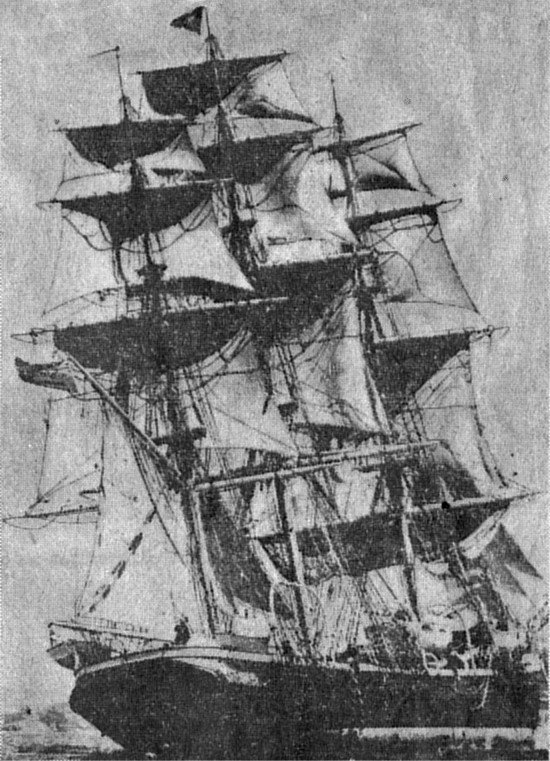"The Way of a Square-Rigged Ship"
Toronto Telegram, November 21, 1953
Schooner Days MCXXXIII (1133)
By C.H.J. Snider

Wheel, full-and-by and nothing off! Lee braces, lifts and halliards, tacks and sheets, all hands! We go square-rigged today, to blow the bugle before this century's greatest Sailor-of-the Sail.
That is Alan Villiers, who is being brought here next week by the Toronto Anglers and Hunters Association. The latter confer a kindness upon all fellow sportsmen and all Toronto in doing this. Villiers comes laden scupper-deep with camera shots of life at sea with Arabs, Portuguese, Scandinavians, Lime-juicers, and other square-riggers, all around the world and from Greenland to Cape Horn. He will show his colored motion film, "The Glory of Sail."
It was my good fortune to see this Citizen of the Seven Seas when he was in New York with his own iron ship, the 60-year-old Joseph Conrad, shining like a million dollars.
Villiers could have passed for a brother of Lt.-Commdr. Nik Beketov, R.C.Y.C., now Superintendent of navigation aids for northern B.C., with two ships under him, for the Department of Transport – square face with round jaw and firm chin, eyes wide apart, deepset under level brows and scanning the horizon of Zanzibar from Manhattan.
His was a boy's face still, after thirty years of "the savage endless enmity of the real sea." He had licked Cape Stiff a dozen times, and cheated Davy Jones oftener.
Alan Villiers is an artist in words, in pictures, in sails and in living. From his cradle he'd loved the great sailing ship, the bigger the better. He betrothed her in his school days, wedded her, and is faithful to her for life. No "power" for him but the wind. No sail for him but square.
He was born Sept. 23, 1903, when towering masts, criss-crossed by stiff-armed yards, made the waterfront of Melbourne a forest of magical delight. He was fifteen when he succeeded in breaking in, pushed by stern necessity of earning a livelihood and pulled by the more potent allure of the sail. He worked his way, for wages always meagre, through degrees of sailordom, cadet, seaman, master, owner and peer of the best of the master-owners, men like Ruben De Cloux or Gustav Erickson, last of the sailing ship fleet owners.
Villiers worked his way also, for wages less meagre but as hardly earned, into literature, pictorial art, and the films. He took a little box camera to sea and used its product when he found a publisher. He has written a score of good books. They show a development in sea-going illustration which make him the Karsh of the ocean.
Villiers latest, "The Way of a Ship," is a panegyric for what he calls "the loveliest of all man's working creations, the square-rigged ship." It is not a swan song, and it ends on a high note.
He gives details of the greatest of the great ships, magnificent creatures, wind driven only, faster than power craft, faster than the valued clippers twice as good carriers, twice as good to their crews. It is a revelation to find Germans leading in the last days of great sail.
"Great sails" means bottoms capable of hauling up to 8,000 tons of needed freight around the world by wind power, ships like the Preussen of the Laeiz "Flying P" line, flower of a century of ship owning by one family.
This Preussen had masts 200 feet high, five of them, every one fully square-rigged, six square sails on each. That makes thirty square sails, and she had besides twelve fore-and-aft stay-sails, four jibs, a spanker, and gafftopsail – forty-eight working sails, no studdingsails or flying kites, but 60,000 square feet of canvas. (The Bluenose, the biggest rig I recall sailing in, had 10,000). The Preussen did 17 and 17 1/2 knots, hour after hour, watch after watch. Her average was 7 1/2 knots all the time, calm, gale and headwind. She was 430 feet long, and was sailed by a crew of 44, well fed, berthed in comfort. She had three "islands," raised decks which kept her men out of the water and on board all the time, and she had those boons to deep-watermen by Scotch skipper-inventor Capt. J. C. B. Jarvis, brass-winches, which rendered drowning and backbreaking unnecessary.
